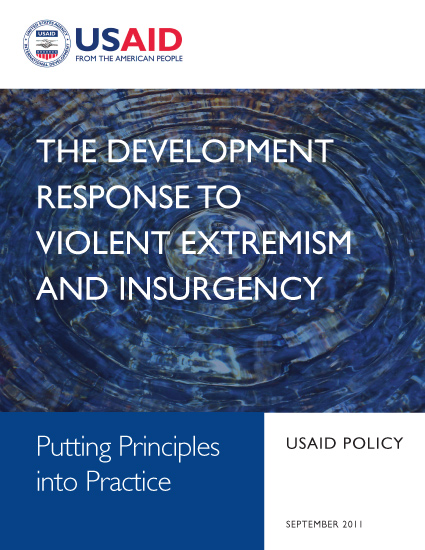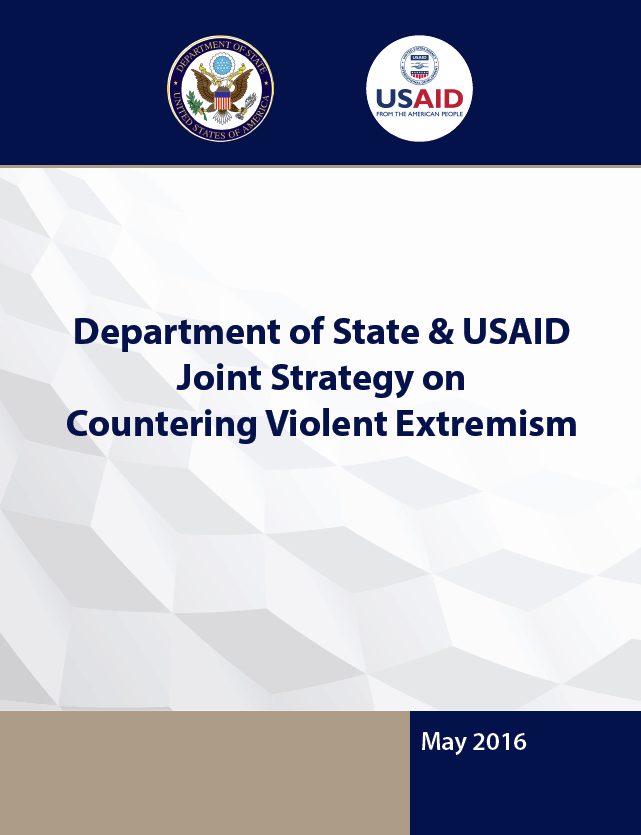- What We Do
- Agriculture and Food Security
- Democracy, Human Rights and Governance
- Economic Growth and Trade
- Education
- Ending Extreme Poverty
- Environment and Global Climate Change
- Gender Equality and Women's Empowerment
- Global Health
- Water and Sanitation
- Working in Crises and Conflict
- Disaster Assistance
- Political Transition Initiatives
- Conflict Mitigation and Prevention
- Countering Violent Extremism
- Disaster Risk Reduction
- Peacebuilding and Reconciliation
- Providing Safe & Secure Environments for Development
- Recovering From Crisis
- Resilience
- Tech Challenge for Atrocity Prevention
- World Humanitarian Day
- U.S. Global Development Lab
The U.S. Agency for International Development (USAID) has long recognized the critical role of development in addressing social, economic, governance, and other grievances that can fuel violent extremism or radicalization of individuals and communities. The impact of violence and fragility that ensues from extremist violence impedes development. For instance, it can slow investment, prevent children from attending schools, place additional burdens on already fragile health care systems, and undermine political transitions. In fact, more than half of State and USAID’s assistance goes to countries in the midst of conflict, or trying to prevent state failure.
In 2011, in recognition of the importance of identifying and addressing the root causes of extremism, the Agency issued The Development Response to Violent Extremism and Insurgency policy. This policy provides guidelines on using development programming to address the deep lying issues that foment extremist violence and fragility. USAID currently manages programs that specifically address drivers of violent extremism in Africa, the Middle East, and Asia. The agency also programs funds in cross-regional programs in the Maghreb and Sahel in close coordination with State Department and other inter-agency efforts, and in particular, the Trans-Sahara Counter-Terrorism Partnership Fund, for which USAID is a key implementing agency.
Based on rigorous, locally-informed assessments and analysis, USAID’s approach has concentrated on youth empowerment, social and economic inclusion, media and messaging, improved local governance,reconciliation, and conflict mitigation. Activities are tailored to meet the specific threat levels, political environments, and material needs of each community. Our CVE efforts target distinct populations, to calibrate responses. For example: at-risk young men, and increasingly, the unique role of women in promoting peace and security.
USAID is constantly gathering both quantitative and qualitative data to design, monitor and evaluate this programming. Assessments and analysis, including on specific countries and on the role of women, are helping design programs in Central Asia, the Middle East, Africa and the Balkans. In Africa, USAID has developed web-based training, built knowledge sharing platforms, and convened workshops to assure innovation and learning. USAID shares our lessons learned to help our partners refine approaches to CVE and our programming. Some examples of where USAID is effectively employing its programming include:
REPRESENTATIVE USAID-MANAGED CVE PROGRAMMING
Africa
- Regional Peace for Development II (PDEV II): This program operates in multiple African countries and uses a community-led approach to foster community harmony and stability with a focus on youth empowerment, vocational training, education, research, information dissemination via various channels including radio and good governance.
- USAID’s Transition Initiatives for Stabilization (TIS): The goal of TIS is to enhance Somalia’s stability through participatory processes that promote good governance and community cohesion in locations with a high risk of violent extremism. Quick impact stabilization activities will be a key programmatic focus given the fragile nature of the nascent government and the continued insurgency in parts of South-Central Somalia.
- Kenya Transition Initiative (2011-2014): In one of its first explicit CVE programs, USAID sought to counter radicalization of Somali youth in Nairobi. After research identified local pull factors, USAID worked to build local demand for moderation and non-violence by creating communication channels for discussion of sensitive topics, empowering local youth through reinforcing community leadership and positive identity formation, and bolstering links between youth and skill-building opportunities.
- Nigeria Regional Transition Initiative (2014 – Present): USAID assists U.S. policy goals of bolstering stability and democratic institutions in areas of Northeast Nigeria most affected by violent extremism. This program promotes improving government responsiveness to citizen expectations, reducing perceptions of marginalization particularly in isolated communities, and reducing youth vulnerability to violent extremist influences.
- Niger Community Cohesion Initiative (2014 – Present): USAID activities address the threat of violent extremism caused by social marginalization and political exclusion. Working with vulnerable communities in the regions of Agadez and Diffa, which borders Nigeria, the program promotes resistance to instability and extremism among youth and generates dialogue between local authorities, communities, and marginalized groups.
- Mali Transition Initiative (2013 – Present): USAID works to counter the appeal of violent extremism in the country’s northern areas, by increasing the social, economic, and political inclusion of marginalized communities that are susceptible to messaging from violent extremist organizations including Al-Qaeda in the Islamic Maghreb.
Middle East and North Africa
- Maghreb-Sahel Capacity Building for Countering Violent Extremism: This program will support communities and civil society organizations to develop and implement strategies to counter violent extremism. It is designed to counter efforts by violent extremists and to help reduce the flow of foreign terrorist fighters.
- Middle East and North Africa: USAID’s Office of Transition Initiatives designed explicit CVE interventions in Tunisia to address key local pull factors, including perceptions of social exclusion and marginality, social networks, and group dynamics. Some USAID programs in the Middle East have added a specific CVE component while others address violent extremism within broader program objectives. Working at the community level, these programs aim to address “push” factors, embedded within context-specific programs that bolster norms of tolerance, responsive governance, conflict mitigation or resilience.
Asia
- Pakistan Transition Initiative (2007 – Present): USAID’s Office of Transition Initiatives USAID programs in Karachi and Southern Punjab seek to counter violent extremism in order to build a foundation for political and social development in conflict-prone communities in Pakistan. Working with concerned ministries, local governments, community groups, and the private sector, USAID provides positive opportunities for residents to develop skills, reinforce values of tolerance and mutual respect, and develop counter-narratives. Separately, in Pakistan’s FATA/KP region, USAID supports the Pakistani government’s efforts to make communities resilient to extremists by strengthening community-government ties through locally-driven projects.
- Central Asia (2015 – Present): Drawing upon on research pointing to labor migrants as the main group vulnerable to radicalization, USAID is piloting programs that address labor trafficking and the reintegration of labor migrants returning from work abroad in Russia under its Dignity and Rights Program as well as exploring livelihoods support for returning labor migrants.









Comment
Make a general inquiry or suggest an improvement.